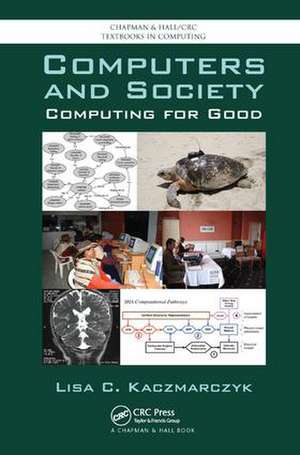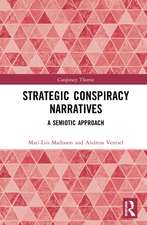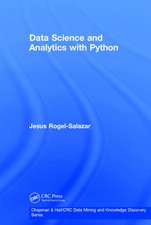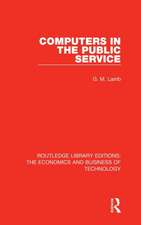Computers and Society: Computing for Good: Chapman & Hall/CRC Textbooks in Computing
Autor Lisa C. Kaczmarczyken Limba Engleză Hardback – 27 iul 2017
| Toate formatele și edițiile | Preț | Express |
|---|---|---|
| Paperback (1) | 590.46 lei 6-8 săpt. | |
| CRC Press – 14 dec 2011 | 590.46 lei 6-8 săpt. | |
| Hardback (1) | 1335.85 lei 6-8 săpt. | |
| CRC Press – 27 iul 2017 | 1335.85 lei 6-8 săpt. |
Din seria Chapman & Hall/CRC Textbooks in Computing
- 8%
 Preț: 476.14 lei
Preț: 476.14 lei - 20%
 Preț: 468.95 lei
Preț: 468.95 lei - 20%
 Preț: 745.40 lei
Preț: 745.40 lei - 9%
 Preț: 602.23 lei
Preț: 602.23 lei - 20%
 Preț: 566.10 lei
Preț: 566.10 lei - 20%
 Preț: 586.30 lei
Preț: 586.30 lei - 20%
 Preț: 643.08 lei
Preț: 643.08 lei - 20%
 Preț: 390.05 lei
Preț: 390.05 lei - 20%
 Preț: 1004.02 lei
Preț: 1004.02 lei - 30%
 Preț: 489.15 lei
Preț: 489.15 lei - 20%
 Preț: 690.64 lei
Preț: 690.64 lei - 20%
 Preț: 320.57 lei
Preț: 320.57 lei - 20%
 Preț: 374.08 lei
Preț: 374.08 lei - 20%
 Preț: 619.66 lei
Preț: 619.66 lei - 28%
 Preț: 266.34 lei
Preț: 266.34 lei - 20%
 Preț: 590.46 lei
Preț: 590.46 lei - 20%
 Preț: 761.07 lei
Preț: 761.07 lei - 20%
 Preț: 657.55 lei
Preț: 657.55 lei - 31%
 Preț: 323.84 lei
Preț: 323.84 lei - 30%
 Preț: 353.30 lei
Preț: 353.30 lei
Preț: 1335.85 lei
Preț vechi: 1669.82 lei
-20% Nou
Puncte Express: 2004
Preț estimativ în valută:
255.60€ • 266.90$ • 211.08£
255.60€ • 266.90$ • 211.08£
Carte tipărită la comandă
Livrare economică 15-29 aprilie
Preluare comenzi: 021 569.72.76
Specificații
ISBN-13: 9781138432901
ISBN-10: 1138432903
Pagini: 316
Dimensiuni: 156 x 234 x 19 mm
Greutate: 0.62 kg
Ediția:1
Editura: CRC Press
Colecția CRC Press
Seria Chapman & Hall/CRC Textbooks in Computing
Locul publicării:Boca Raton, United States
ISBN-10: 1138432903
Pagini: 316
Dimensiuni: 156 x 234 x 19 mm
Greutate: 0.62 kg
Ediția:1
Editura: CRC Press
Colecția CRC Press
Seria Chapman & Hall/CRC Textbooks in Computing
Locul publicării:Boca Raton, United States
Recenzii
One of the most challenging topics to teach in the undergraduate computing curricula is the social and ethical implications of computing. … Kaczmarczyk’s book is a great help in answering these questions. … many well-crafted, open-ended questions and projects at the end of the chapters guide student work and discussion. The case studies are carefully researched and presented at an appropriate level for students to study any time after their freshman year. … What can one do with a degree in computing? What opportunities are there to use such a degree for good? The book is unique and successful in pulling together answers to these questions. It shares the stories of people who have used their technical skills to positively affect the lives of many people, both directly and indirectly. I know of no other book like this one.
—Anthony J. Duben, Computing Reviews, May 2012
Computers and Society: Computing for Good contains in-depth case studies with extensive, thought-provoking end-of-chapter questions and is appropriate for a wide variety of undergraduate and graduate majors in areas such as Computer Engineering, Computer Science, Computer Information Science, Information Technology, Health Information Science, Business Management, and Political Science as well as many other areas. The complex nature of the case studies allows them to be used in a stand-alone social and professional issues course, a capstone issues course, or as individual case studies that may be woven into a variety of computing or business courses.
Kaczmarczyk’s book contains a unique and fresh look at how people from a variety of disciplines use computing and how the use of computing impacts these individuals as well as society.
Kaczmarczyk’s book should be a ‘must have’ book for all college or university libraries.
—Carol L. Spradling, PhD, Associate Professor, Northwest Missouri State University
—Anthony J. Duben, Computing Reviews, May 2012
Computers and Society: Computing for Good contains in-depth case studies with extensive, thought-provoking end-of-chapter questions and is appropriate for a wide variety of undergraduate and graduate majors in areas such as Computer Engineering, Computer Science, Computer Information Science, Information Technology, Health Information Science, Business Management, and Political Science as well as many other areas. The complex nature of the case studies allows them to be used in a stand-alone social and professional issues course, a capstone issues course, or as individual case studies that may be woven into a variety of computing or business courses.
Kaczmarczyk’s book contains a unique and fresh look at how people from a variety of disciplines use computing and how the use of computing impacts these individuals as well as society.
Kaczmarczyk’s book should be a ‘must have’ book for all college or university libraries.
—Carol L. Spradling, PhD, Associate Professor, Northwest Missouri State University
Cuprins
Poverty Alleviation in the Remote Peruvian Andes. Improving Patient Care with Digital Image Management. Internet Voting for Overseas Citizens. Social Networking and Computer Modeling Aid Sea Turtles. Best Practice Recommendations in Children's Medical Care. Protecting Lives Using the Results of Earthquake Modeling. When Following Your Passion Means Forming Your Own Business.
Notă biografică
Lisa C. Kaczmarczyk is currently an external evaluator on National Science Foundation-funded research projects. She has over 18 years of experience teaching and researching applied learning theory in computer science education. Dr. Kaczmarczyk is a member of the ACM Education Council and an associate editor of ACM Inroads. She earned a Ph.D. from the University of Texas at Austin, master's degrees from the University of Oregon and Northeastern University, and a B.A. from Tufts University. You can access her blog at http://computing4society.blogspot.com
Descriere
There is a growing awareness across both public and private sectors, that the key to embedding an effective risk culture lies in raising the general education and understanding of risk at every level in the organization. This is exactly the purpose of David Tattam's book. A Short Guide to Operational Risk provides you with a basic yet comprehensive overview of the nature of operational risk in organizations. It introduces operational risk as a component of enterprise wide risk management and takes the reader through the processes of identifying, assessing, quantifying and managing operational risk; explaining the practical aspects of how these steps can be applied to an organization using a range of management tools. The book is fully illustrated with graphs, tables and short examples, all designed to make a subject that is often poorly understood, comprehensible and engaging. A Short Guide to Operational Risk is a book to be read and shared at all levels of the organization; it offers a common understanding and language of risk that will provide individual readers with the basis to develop risk management skills, appropriate to their role in the business.

























